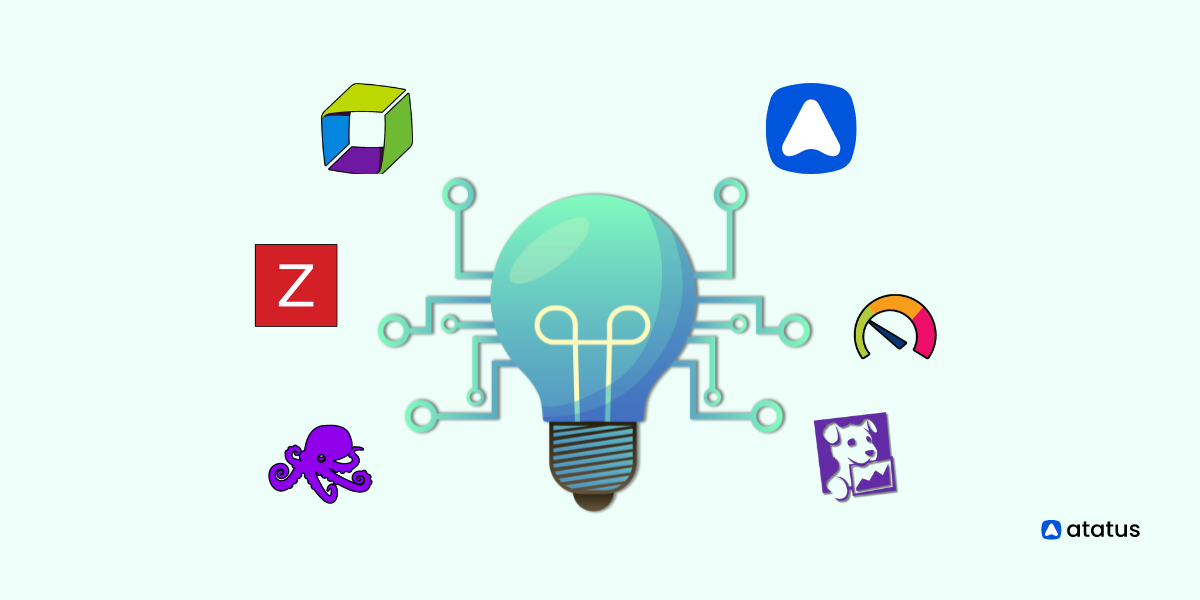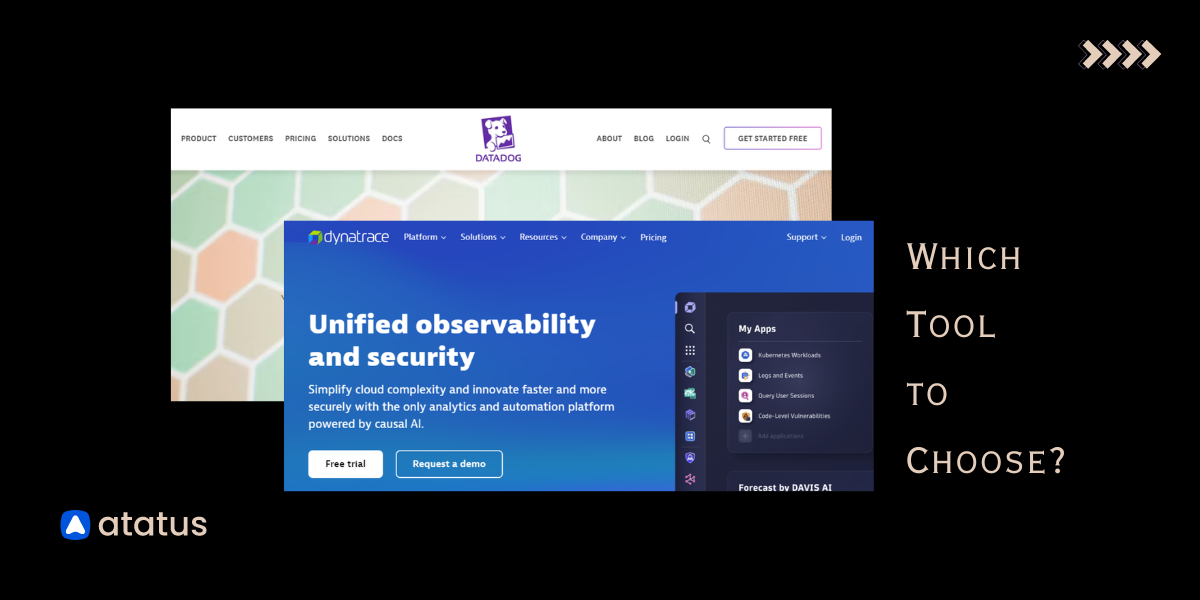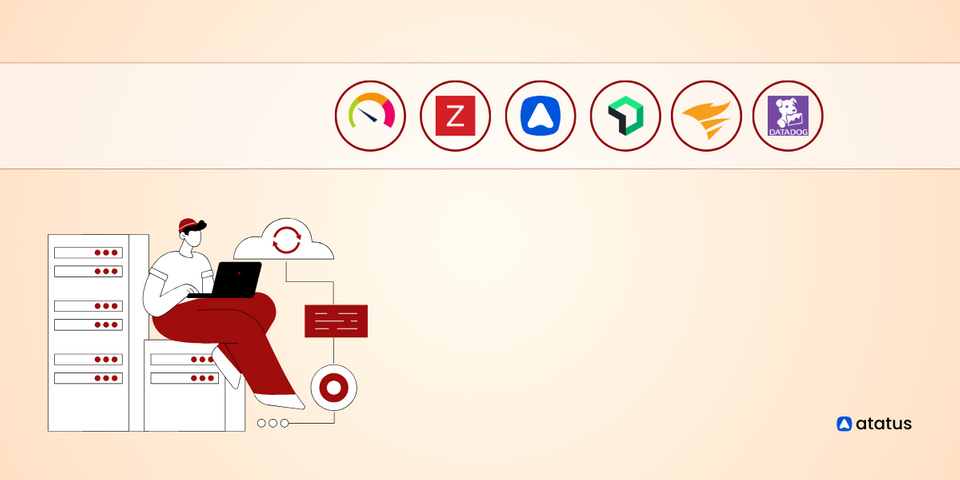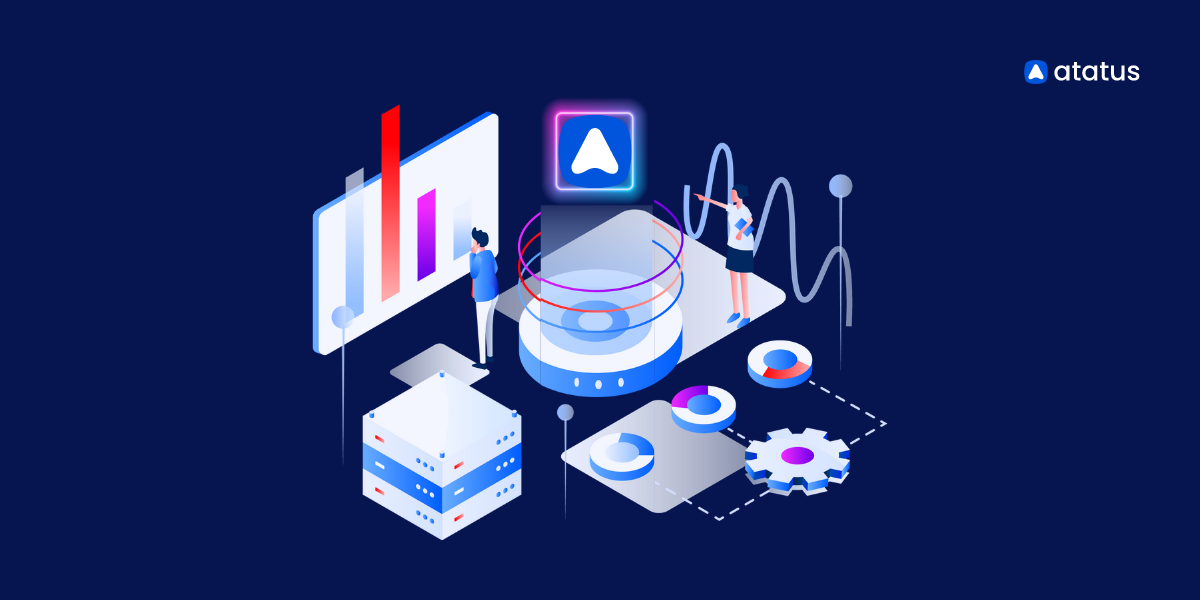Part 3: Infrastructure Monitoring Tools
From networking and servers to databases and applications, the infrastructure is the backbone of an organization's operations.
With the rise of digitalization, the need for reliable and efficient infrastructure has become more important than ever. Whether it be transportation systems, communication networks, or energy grids, infrastructure plays a vital role in keeping our society functioning smoothly.
However, with these systems' increasing complexity and scale, it has become essential to have tools that can monitor and manage them effectively. Any downtime or malfunction can result in significant financial losses and damage to a company's reputation.
This is where infrastructure monitoring tools come into play.
These tools provide real-time insights into the performance and health of an organization's entire infrastructure, enabling proactive measures to prevent potential issues. From traditional on-premise solutions to modern cloud-based platforms, we will explore the various tools available and their features.
So, let's delve into the world of infrastructure monitoring and discover how these tools can help organizations stay ahead in the digital age.
We have already discussed the fundamentals of Infrastructure Monitoring in the previous two parts, to get deeper understanding of What is Infrastructure all about, read - Part 1: Infrastructure Monitoring - Getting Started and Part 2: Infrastructure Monitoring Metrics.
Table Of Contents:
- Why Should We Monitor our Infrastructure?
- What to Look for in an Infrastructure Monitoring Tool?
- Top Infrastructure Monitoring Tools:
- Best Pick: Comprehensive Monitoring Solution
Why should we Monitor our Infrastructure?
Monitoring infrastructure is akin to keeping a vigilant eye on the heartbeat of an organization's digital ecosystem. Just as a healthy heartbeat signifies the well-being of an individual, monitoring infrastructure health is imperative for the smooth functioning, reliability, and security of IT systems.
i.) Proactive Issue Detection:
Infrastructure monitoring acts as an early warning system, identifying potential issues before they escalate into critical problems. This proactive approach allows for timely intervention and prevents downtime or performance degradation.
ii.) Performance Optimization:
Organizations can pinpoint inefficiency and optimize resource utilization by continuously observing the performance of servers, networks, and applications. This leads to better performance, improved user experience, and cost-effective resource allocation.
iii.) Enhanced Security:
In the age of cyber threats, monitoring infrastructure is crucial for identifying suspicious activities, potential security breaches, and vulnerabilities. It enables rapid response to security incidents, protects sensitive data, and ensures the integrity of digital assets.
iv.) Capacity Planning:
Monitoring provides valuable insights into resource usage trends over time. This data is essential for capacity planning, helping organizations anticipate future needs, allocate resources effectively, and avoid unexpected capacity constraints.
v.) Efficient Troubleshooting:
When issues do arise, infrastructure monitoring facilitates efficient troubleshooting. It provides detailed information about the root cause of problems, reducing the time needed to identify and resolve issues, minimizing downtime, and improving system reliability.
vi.) Compliance Requirements:
Many industries have regulatory compliance standards that mandate organizations monitor and report on various aspects of their IT infrastructure. Monitoring tools help ensure legal and regulatory compliance.
vii.) Real-Time Visibility:
Real-time monitoring offers a dynamic and up-to-the-minute view of the entire IT landscape. This visibility is invaluable for making informed decisions, responding promptly to changes, and proactively managing the digital environment.
viii.) Resource and Cost Management:
Monitoring enables organizations to track resource utilization and associated costs. This information is instrumental in optimizing operational expenses, avoiding unnecessary expenditures, and ensuring the most efficient use of available resources.
ix.) Scalability:
As organizations grow, so does their digital footprint. Infrastructure monitoring tools provide scalability, allowing businesses to seamlessly expand their monitoring capabilities to accommodate an increasing number of devices, applications, and users.
x.) Continuous Improvement:
Monitoring is not just about identifying problems but also about continuous improvement. Organizations can learn from past incidents by analyzing historical data, fine-tune their infrastructure, and implementing best practices for ongoing enhancement.
What to look for in an Infrastructure Monitoring Tool?
It is always best to divide our search into two directions - where technical standpoint matters and general use case matters. And based on that, I have listed what features must top your list when choosing an Infrastructure Monitoring Tool.
Technical Features
a) Scalability
The tool should scale seamlessly to accommodate the growth of your infrastructure. It should be able to handle an increasing number of devices, servers, and applications without compromising performance.
b) Multi-platform Support
Ensure the monitoring tool is compatible with various operating systems, cloud platforms, and virtualization technologies. This flexibility is vital for organizations with diverse IT environments.
c) Real-time Monitoring
Real-time monitoring capabilities allow for immediate detection and response to issues. Look for tools that provide real-time alerts and dashboards to keep you informed about the current state of your infrastructure.
d) Customizable Dashboards
The ability to create customized dashboards tailored to your specific needs helps in presenting relevant information at a glance. This feature enhances user experience and streamlines decision-making.
e) Alerting and Notification
A robust alerting system is crucial for timely response to issues. Look for tools that support customizable alert thresholds, multiple notification channels (email, SMS, etc.), and integration with incident management systems.
f) Historical Data Analysis
Long-term data storage and analysis capabilities enable trend analysis and historical performance tracking. This is valuable for capacity planning, identifying recurring issues, and assessing the impact of changes over time.
g) Automated Remediation
Some advanced monitoring tools offer automation features to resolve common issues automatically. Automated remediation can significantly reduce downtime and improve system reliability.
h) Integration APIs
Ensure the tool provides robust APIs for easy integration with other systems, such as ticketing systems, collaboration tools, and orchestration platforms. This facilitates a more cohesive and efficient IT ecosystem.
i) Comprehensive Protocol Support
The tool's ability to monitor various protocols, including SNMP, WMI, HTTP, and others, ensures that it can gather data from a wide range of devices and applications.
General Features
a) User-Friendly Interface
An intuitive and user-friendly interface is essential for efficient usage. Look for tools that prioritize ease of use to reduce the learning curve for your team.
b) Role-based Access Control
Granular access control ensures that team members have access only to the specific data and features relevant to their roles. This enhances security and prevents unauthorized access.
c) Community and Support
A strong user community and reliable customer support are invaluable. Check for documentation, forums, and customer support options to ensure you have assistance when needed.
d) Cost-Effectiveness
Evaluate the pricing model to ensure it aligns with your budget and usage requirements. Some tools offer flexible pricing based on the number of devices or resources monitored.
e) Vendor Reputation
Consider the reputation and track record of the monitoring tool vendor. Choose a vendor with a history of providing reliable solutions and continuous updates.
f) Compliance and Reporting
For organizations with specific compliance requirements, the tool should support reporting features that assist in demonstrating adherence to regulations.
g) Mobile Access
Mobile access to monitoring dashboards and alerts is crucial for on-the-go management. Look for tools that provide mobile apps or responsive web interfaces.
h) Upgrade and Compatibility Policies
Understand the vendor's policies regarding software updates, patches, and compatibility with new technologies. This ensures that your monitoring solution remains relevant and secure over time.
By carefully considering these technical and general features, you can select an infrastructure monitoring tool that aligns with your organization's specific needs and helps maintain a resilient and high-performance IT environment.
Top Infrastructure Monitoring Tools
Based on the technical and general features listed above, I’ve curated a list of the most efficient and trending tools in this area as of now. Take a look at their features, consider the pros and cons, and determine whether they fit within your budget range and decide for yourself!
1. Atatus
Atatus is a full-stack application performance monitoring solution that is customizable for small businesses to enterprise-level applications. Their product - Infrastructure Monitoring, is one such stalwart in their list of innovative monitoring solutions.
Guard the backbone of your digital operations with their Infrastructure Monitoring solution, which tracks system health, resource utilization, and potential vulnerabilities across all your servers, networks, and hardware anytime. Atatus ensures peak performance and proactive issue resolution even in the worst-case scenarios.
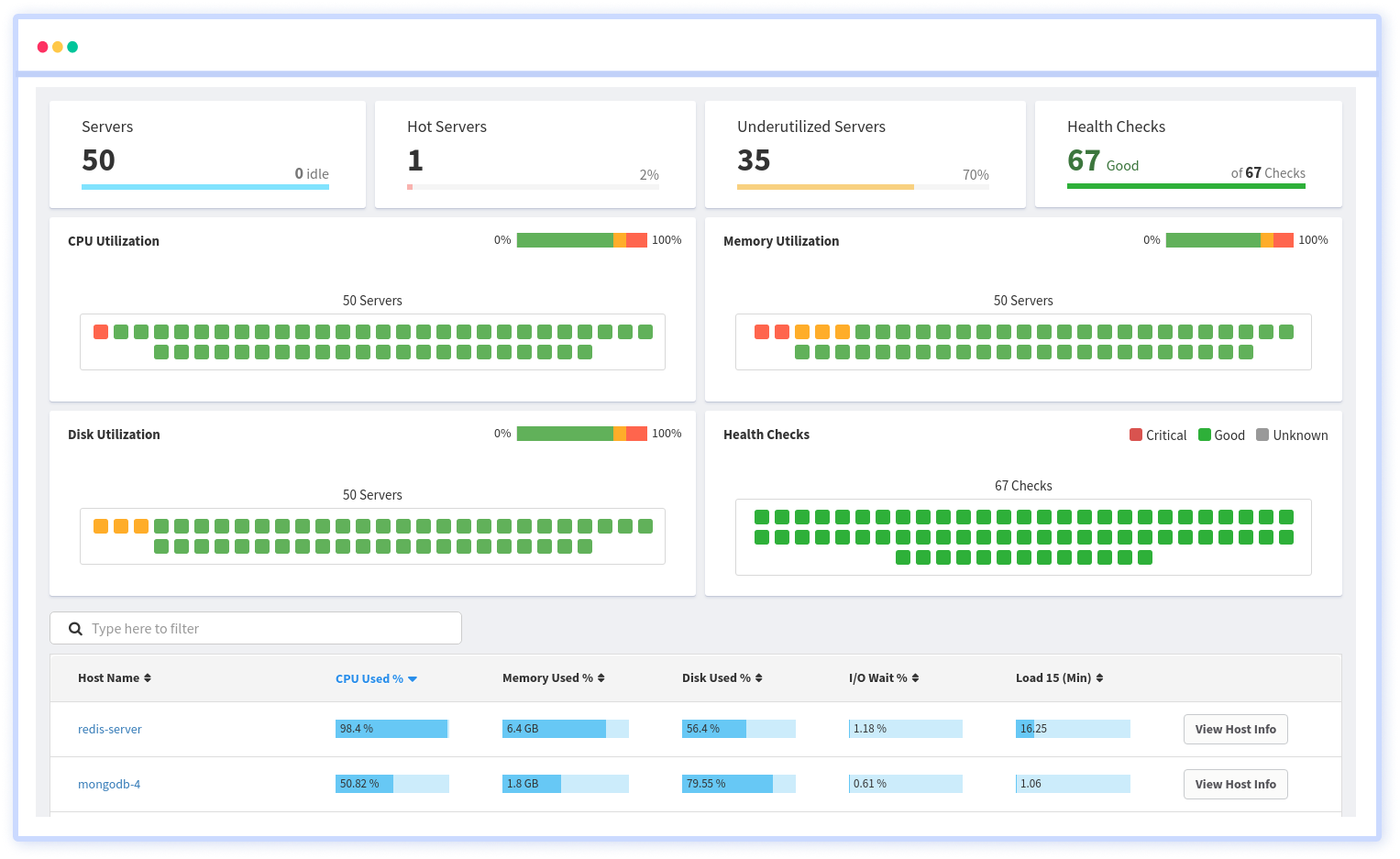
Features:
- Tracks server-level metrics such as CPU usage, memory usage, disk I/O, and network activity
- Monitors containerized environments, providing insights into the performance of Docker containers and Kubernetes clusters
- Offers support for monitoring infrastructure across various cloud providers (e.g., AWS, Azure, GCP)
- Tracks and manages the inventory of infrastructure components, including servers and containers
- Search, filter, and group packages and inventory data
- Correlate application issues with underlying infrastructure problems
Pricing:
Atatus offers you quality services at minimal rates, which are visible from their pricing plans. They offer infrastructure monitoring at $0.021 per host per month if billed annually and $0.028 when billed monthly. On top of this, they offer a 14-day free trial period without credit-card.
2. Passler PRTG
Offering both agent-based and agentless monitoring services, PRTG network monitoring is a comprehensive tool offering infrastructure monitoring for servers, networks, VMs and applications. PRTG also boasts of an impressive built-in dashboard that gives more visibility to the metrics monitored.
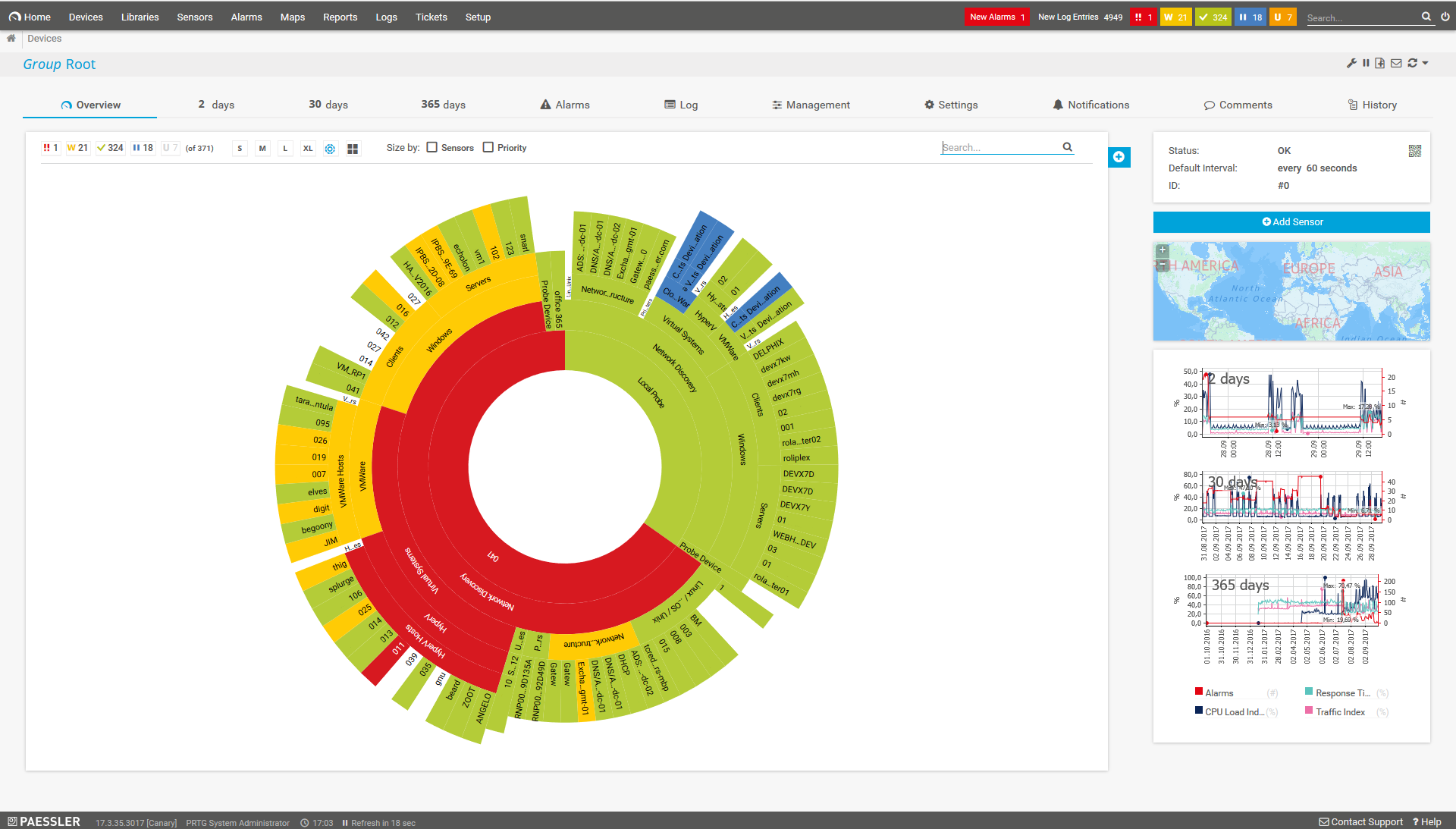
Features:
- Easy set-up: you can install the program locally or use a hosted version
- Issues are dealt with in great detail
- They have a customizable visualization feature, which makes interpreting easier
- Easy and customizable alerts through emails, messages, and apps of your choice
Pricing:
Pricing starts at $1750 for 500 nodes for infrastructure monitoring, but they offer a consoling 30-day free trial period. All of PRTG’s monitoring suites come with a perpetual license that is valid forever, but you will have to pay regular maintenance charges alone.
3. OpManager
ManageEngine’s OpManager offers real-time monitoring into servers, VMs, storage devices and other physical infrastructure. This software also lets you monitor your servers proactive using multiple thresholds (e.g., at different levels of performance). Additionally, the tool can discover and map availability and response-time monitors to all services running on Windows and Linux servers.
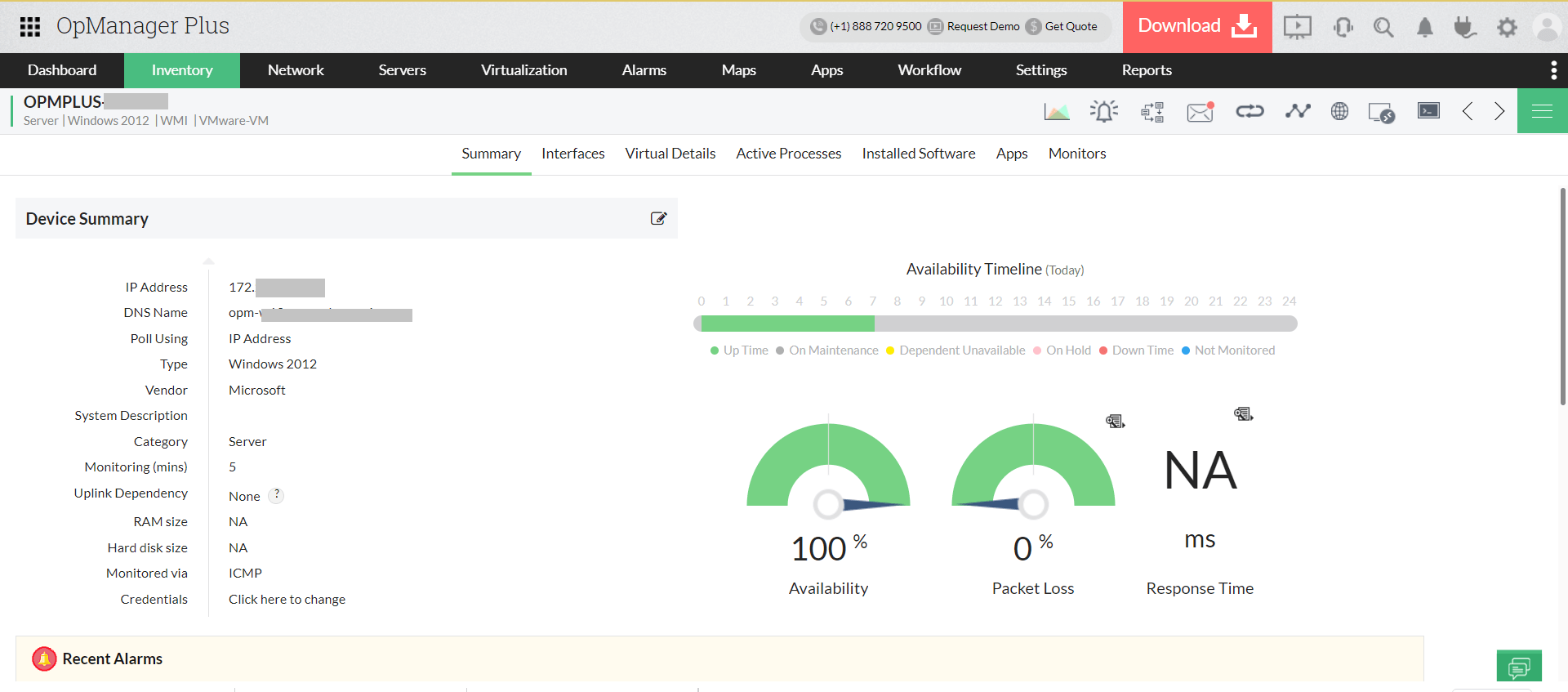
Features:
- Offers Virtual and physical infrastructure monitoring, bandwidth monitoring and change monitoring
- Offers in-depth log and IP address monitoring
- They have a multi-channel notification system which keeps you informed all the time
- L1 and L2 fault management activities are automated
- Integrates with any external tool that supports REST API integration
4. Zabbix
Zabbix is a lightweight agent which is centrally managed by the Zabbix server. It is a versatile tool offering monitoring solutions for networks, servers, infrastructure, cloud and databases. It provides automated discovery features and customizable templates for the same.
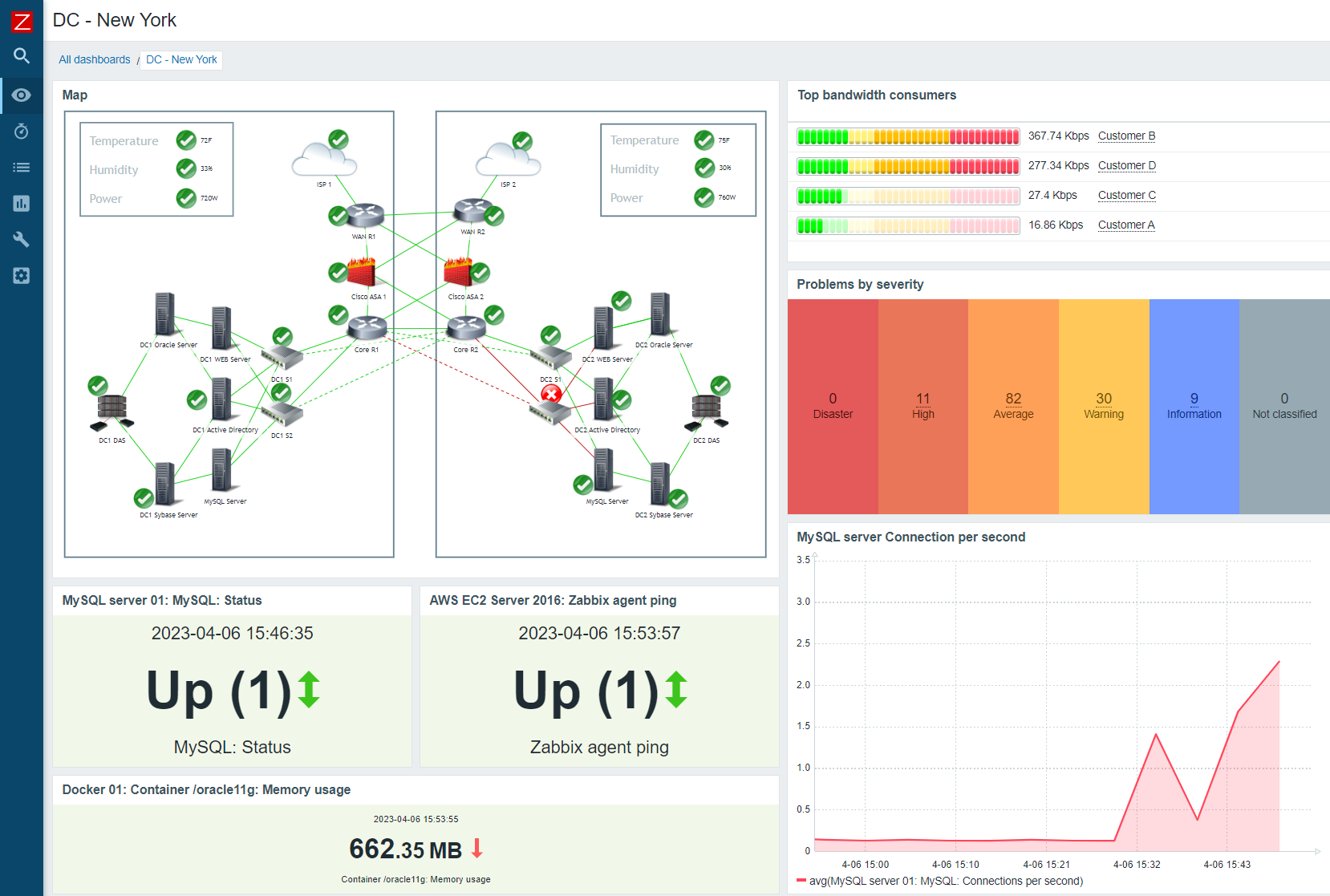
Features:
- Supports multiple platforms like Unix, Linux, and Windows.
- It is open-source, so has a vibrant and large community for any help
- Good visualization features with dashboards, indices, and reports
- Integrates with third-party tools via Zabbix API
- Sadly, they don’t yet offer a SaaS version
Pricing:
Zabbix is free to use as it is open-source, but in case you need an upgrade on any features like technical consultation plans or services, they might charge you accordingly. You can just ring them up and get the range details for these customized services.
5. SolarWinds Server & Application Monitor
SAM streamlines the onboarding process by offering predefined OS monitoring configurations for both Windows and Linux. This feature accelerates the setup phase, ensuring a faster and more efficient deployment of performance monitoring for operating systems. It supports WMI, SNMP, Powershell, and REST API.
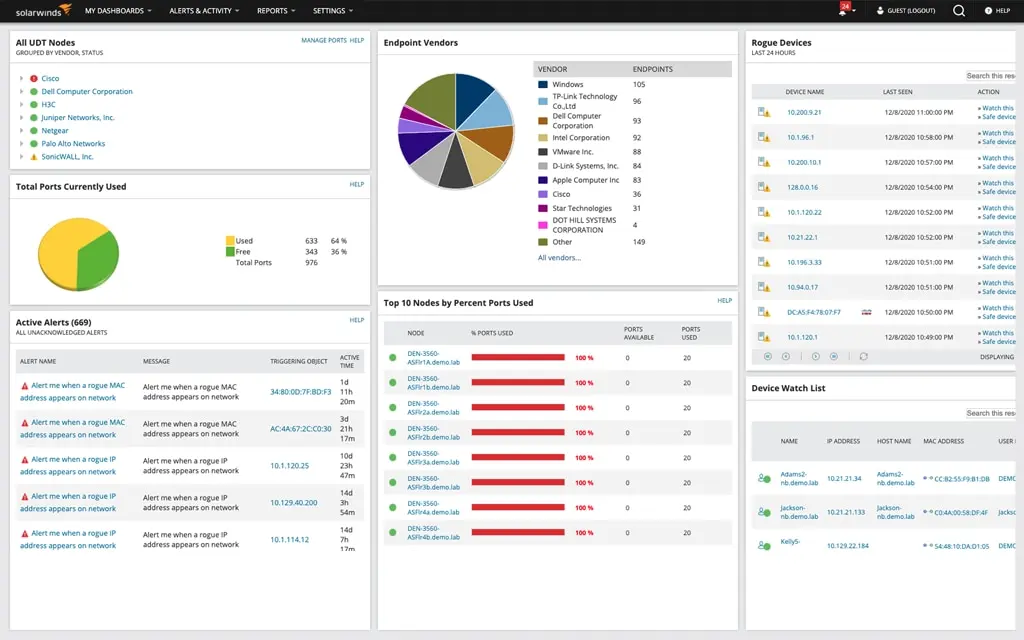
Features:
- Broad compatibility across different infrastructures as it supports multiple tools like WMI.
- Single console performance monitoring, heat monitoring, and power supply and hard drive checks
- Vendor-agnostic hardware monitoring features - popularly used for HP, Dell, IBM etc
- Real-time process explorer to view data for both monitored and unmonitored processes
Pricing:
SolarWinds pricing starts at $1622 and goes upwards to $2995 for upto 10 nodes, but they offer a full free trial for 30 days.
6. Nagios XI
Nagios XI is the newer paid enterprise version of their Nagios core feature. Nagios core, being Linux-based, has commanded quite a place for its architecture. It is extensible vis plugins. Nagios XI features monitoring capabilities for CPU, storage, disk, and other infrastructure components.
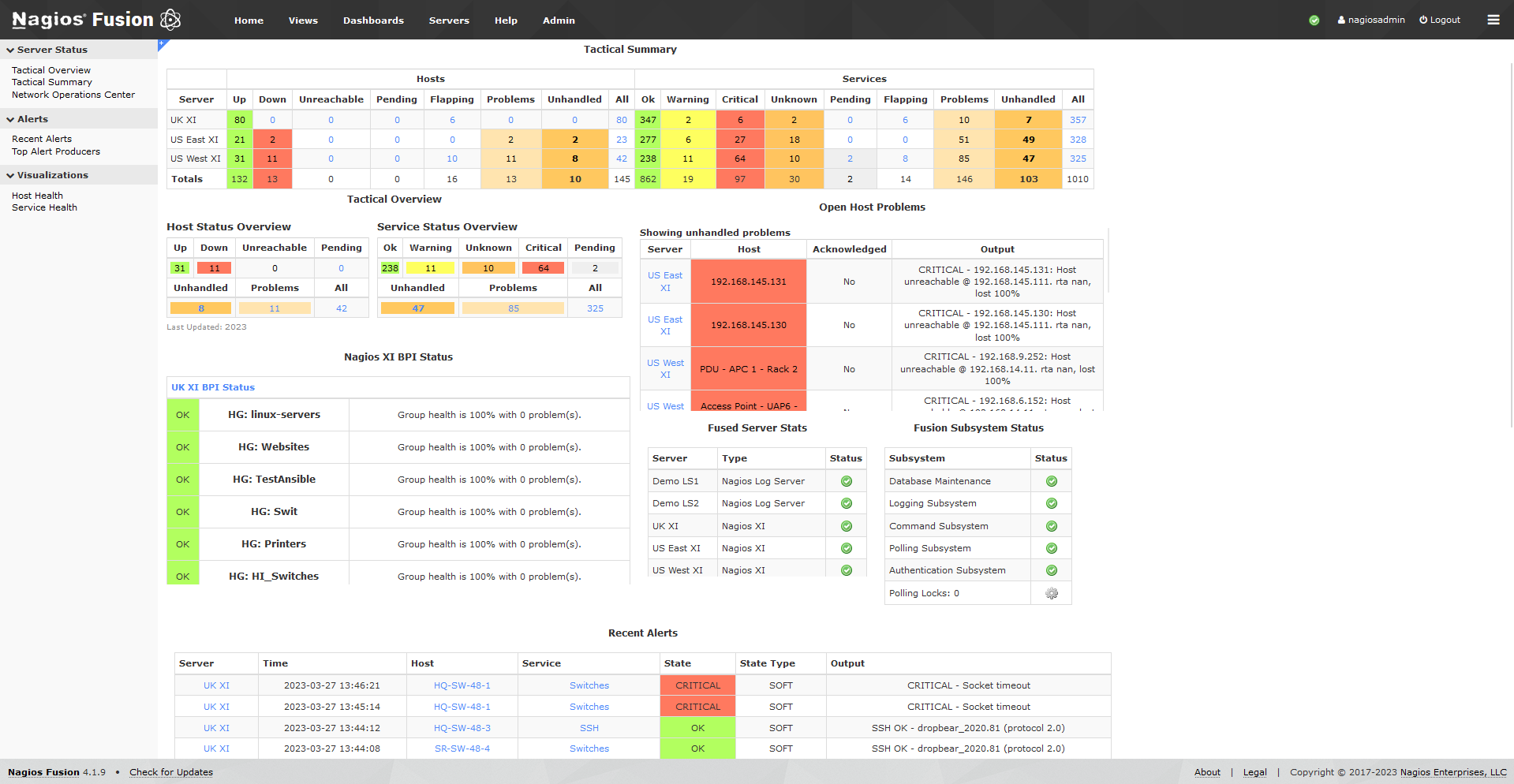
Features:
- Offers reports in a very extensive manner, with even historical reports for analysis and comparison
- Through a web interface, you can view the status of your IT infrastructure in a single pane
- Event handlers provide automated remediation capabilities
- Since Nagios core is open-source, you get full access to source code
Pricing:
Nagios XI has two version - standard version starting at $1995 for 100 nodes and an Enterprise version starting at $3495 per 100 nodes.
7. Dynatrace
Dynatrace is a known name in the field of IT monitoring. Living upto their name, they have an agent deployed per host that collects data on everything - databases, servers, applications, etc. Dynatrace’s extensive infrastructure monitoring can be deployed on the cloud, on-premises or even in hybrid environments.
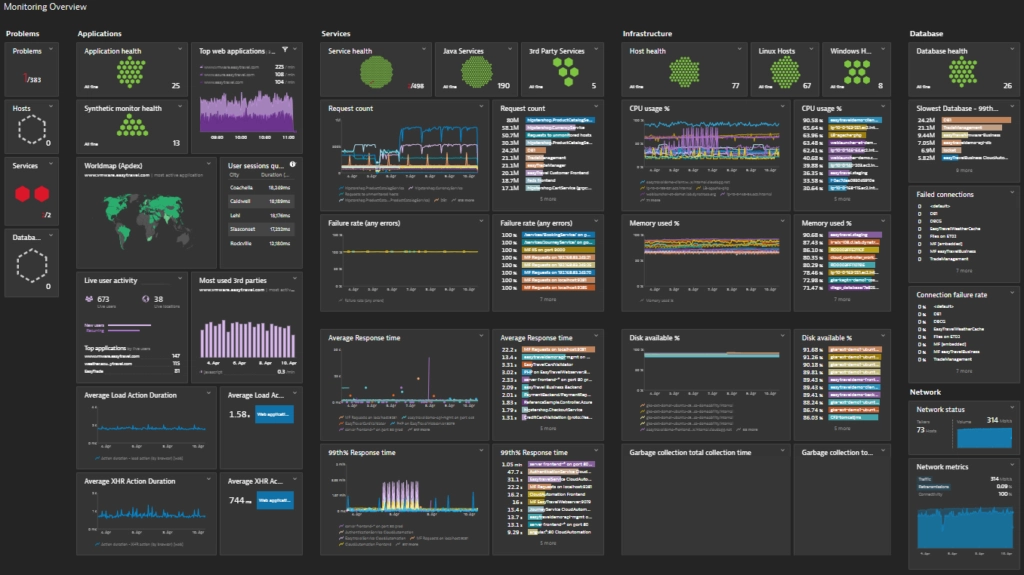
Features:
- Dynatrace gives automated discovery and dependency mapping skills
- It is a comprehensive tool, so the learning curve might be a bit higher and the interface more complex
- There are integrations to monitor other applications like Docker, Kubernetes, and Openshift
- It uses one agent SDK for deployment across multiple components
- Impressive dashboards for visualization
Pricing:
Dynatrace is a bit on the pricier side, they provide infrastructure monitoring at $21 per month for hosts up to 8GB memory.
8. Datadog
Datadog has a host of monitoring and visualization tools available. Their infrastructure monitoring solution uses an open-source agent that allows up to 450 integrations, including Kafka and others.
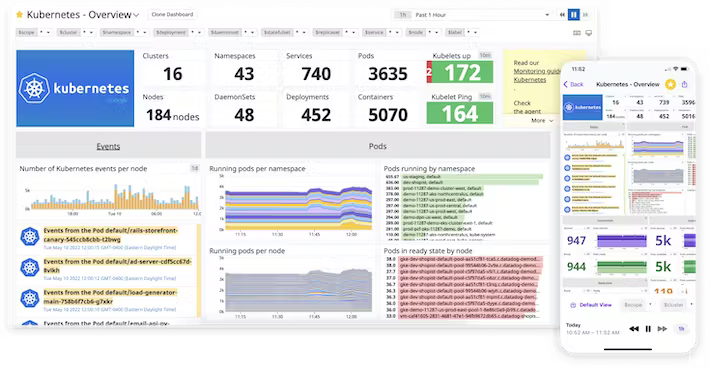
Features:
- All-in-one monitoring platform with logs, metrics, security, and traces
- Holistic dashboards with intricate metric details that tell you even the most sensitive eros
- Customizable dashboards and visualizations
- Alerting, notifications at par with other popular tools
- Offers both cloud and on-premises monitoring capabilities
Pricing:
Datadog offers infrastructure monitoring solutions in three price tiers - free version with 5 hosts where the metrics will be retained for a day, pro version at $15 per month and enterprise version at $23 per host per month.
9. Sematext
Sematext gives you complete infrastructure visibility, whether on-premises or on the cloud. With Sematext, you can monitor the performance of applications, servers, cloud infrastructure, databases, processes inventory, etc.
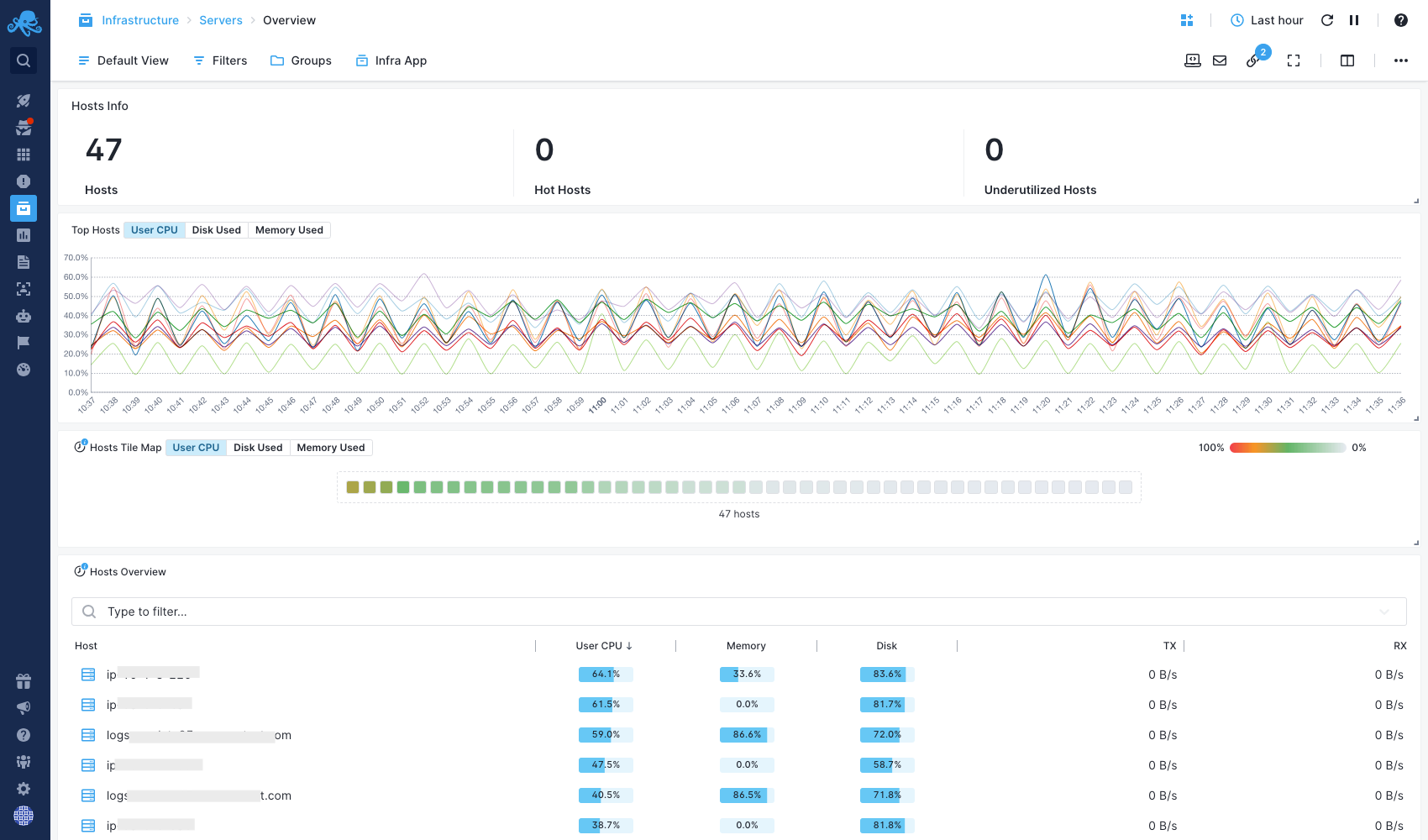
Features:
- Boasts autodiscovery and dependency mapping
- You can monitor infrastructure across Docker, Kubernetes, Docker Swarm, and Nomad
- You can customize alerts and notifications according to your choice
- Can integrate with over 100+ third-party applications
Pricing:
They offer a basic free version for up to 5 hosts per month for a 30-minute retention period. Then, they offer a standard version costing $3.6 per host per month with a retention period of 7 days. The next is a Pro version costing $5.76 per host per month with a 7-day retention period.
Best Pick: Comprehensive Monitoring Solution
Among the myriad options available, Atatus emerges as the standout choice. It offers a comprehensive solution that addresses the diverse needs of today's IT landscape.
Atatus is the best pick for infrastructure monitoring due to its unique features, ease of use, and unparalleled support. Its intuitive dashboard provides instant access to critical metrics, alerts, and performance trends, enabling proactive monitoring and rapid response to issues.
Atatus integrates with various technologies, including cloud platforms, container orchestration systems, and popular monitoring tools. This flexibility allows you to leverage Atatus alongside your existing infrastructure stack without extensive retooling or configuration changes.
Its distributed architecture ensures high availability and performance, even in the most demanding environments, while minimizing resource overhead and operational complexity.
Their dedicated support team is available around the clock to assist with any questions or issues, while comprehensive documentation and tutorials empower you to make the most of Atatus's capabilities.
Conclusion
Hundreds of monitoring tools are coming up daily—each offering new features or an upgrade in the existing feature. Holding a candle to any of these is an uphill task. However, developers wishing to outsource these services might have a different problem.
The problem of choosing the best one. With so much being offered, getting lost is easier. And so, we decided to compile an all-inclusive list of top infrastructure monitoring tools. You can decide which tool fits you best
Ultimately, the "best" infrastructure monitoring tool depends on factors such as the specific requirements of your infrastructure, the level of expertise within your team, budget considerations, and integration preferences. Evaluating multiple options and choosing the tool that best aligns with your organization's needs and goals is recommended.
Infrastructure Monitoring with Atatus
Track the availability of the servers, hosts, virtual machines and containers with the help of Atatus Infrastructure Monitoring. It allows you to monitor, quickly pinpoint and fix the issues of your entire infrastructure.
In order to ensure that your infrastructure is running smoothly and efficiently, it is important to monitor it regularly. By doing so, you can identify and resolve issues before they cause downtime or impact your business.

It is possible to determine the host, container, or other backend component that failed or experienced latency during an incident by using an infrastructure monitoring tool. In the event of an outage, engineers can identify which hosts or containers caused the problem. As a result, support tickets can be resolved more quickly and problems can be addressed more efficiently.
Start your free trial with Atatus. No credit card required.
#1 Solution for Logs, Traces & Metrics
APM
Kubernetes
Logs
Synthetics
RUM
Serverless
Security
More

